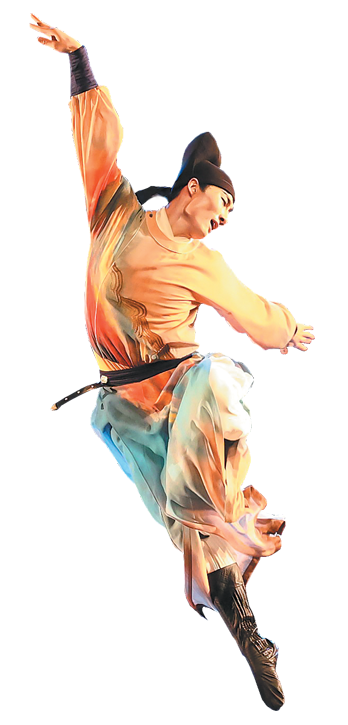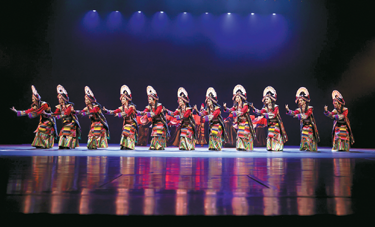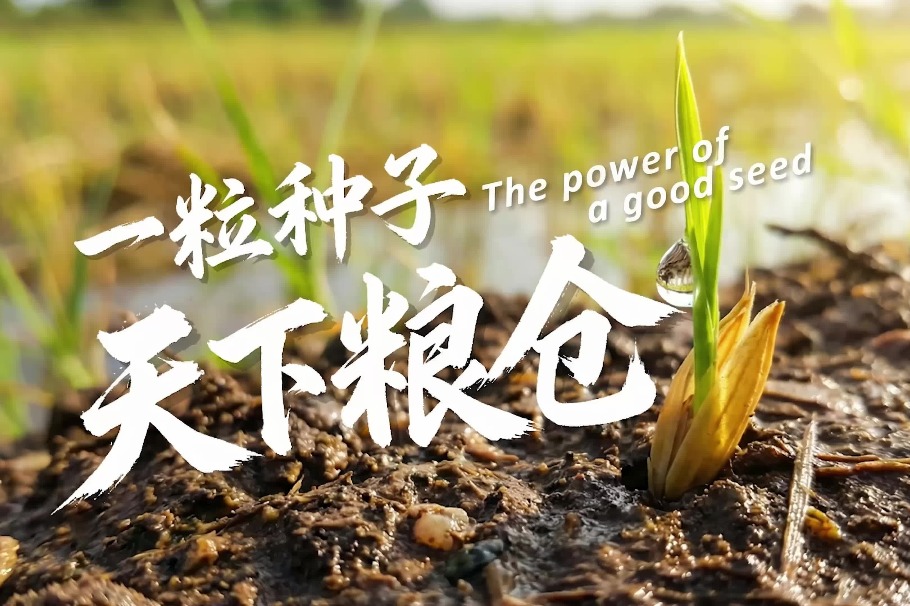Dancing to the next stage of excellence
Event dedicated to performance and teaching of art form continues to produce new, national talent, Chen Nan reports.

When he was a dancer with a local art troupe in Shigatse city, Tibet autonomous region, Kalsang Tenzin traveled to remote parts of Tibet to learn folk dances that were rarely performed onstage.
One day, he visited a small town in Shigatse city where he saw a performance by a group of male dancers. One of them in particular amazed him.
"He was an older man and he danced really well, even though he'd lost his right hand," recalls the 33-year-old. "His passion impressed me, and I decided to learn the dance."
Kalsang Tenzin later learned that it was called Rgyas Gzhas, which means "ceremonious song and dance performance".
Kalsang Tenzin spent four years learning the form and then arranged the choreography for his own dance piece called Rgyas Gzhas — Ancient Charm.
On Aug 13, a group of Kalsang Tenzin's students at Tibet University, where he is now a dance teacher, performed the dance in Beijing, as part of the Achievement Exhibition of the 13th Taoli Cup National Dancing Education Performance of China.
Decked out in colorful Tibetan costumes and exquisite headwear, 12 male and 12 female students performed onstage to the music collected from Tibetan folk artists.
According to Kalsang Tenzin, there are three folk tales related to Rgyas Gzhas, and he combined them in his choreography.
"It is said that Rgyas Gzhas is a dance form born from celebrating battle victories, and that it was created so that the winners of song and dance competitions could celebrate their achievements," Kalsang Tenzin says.
He notes that, according to popular legend, it was performed when Tang Dynasty (618-907) Princess Wencheng traveled all the way from Chang'an (today's city of Xi'an, Shaanxi province) to marry the then Tubo ruler, Songtsen Gampo. The legend is a household story in China, highlighting the connection between the Han and the Tibetan ethnic groups.
"Performers usually wear heavy, sophisticated accessories because the dance is performed for grand ceremonies. For our performance, we simplified the costumes but maintained the essence of the moves, such as the repetitive movements of the head and the focus on the balance of the knees and the movements of the feet," says the man who has been dancing since he was a child.
When he was 12, Kalsang Tenzin moved to Shanghai to study dance at the middle school affiliated to the Shanghai Theatre Academy. In 2015, he came to Beijing to study at the Minzu University of China with a major in dance education, and four years later, he became a teacher at Tibet University.
"Before I learned the dance, I had never even seen Rgyas Gzhas. I have always been told that Tibetan people are hardworking, so we dance by moving our bodies closer to the ground — just like people working on the farm. During the course of this dance, though, we had to maintain graceful, elegant composure, which is quite different to the kind of Tibetan dancing I learned as a child," says 19-year-old Pema Yangzom, who received dance training in Guangzhou, Guangdong province, as a teenager, and enrolled to study at Tibet University a year ago.
This was the first time that she and her classmates were performing in Beijing, she adds, and they were all very excited to travel from Lhasa to the capital.
The 13th Taoli Cup National Dancing Education Performance of China, which was held in Beijing from Aug 9 to Wednesday, featured 200 programs in six sections divided according to style, including classical Chinese dance, Chinese folk dance, ballet and contemporary dance. Students representing 64 schools from 27 cities and provinces participated in the event, making it the largest event in the history of the cup.
Since 1985, the event, formerly known as the Taoli Cup National Dancing Competition, has been held every three years. In 2016, its focus was shifted to take on an educational aspect, and the event was renamed. This year, the cup was organized by the Beijing Dance Academy and focused on student performances, teaching displays and dance forums. A grand gala was held to mark the end of the event on Wednesday.
"For students from faraway regions, it's a great and rare opportunity to meet and talk to dance teachers and students from other parts of the country. All of us were very happy when we knew that we would attend this year's Taoli Cup. We have been preparing for it since March," says Li Feng, a teacher from Xinjiang Normal University, in Urumqi, capital of the Xinjiang Uygur autonomous region.
Li made his choreographic debut with a piece titled Football Boys' Champion Dream, which was performed during this year's cup. Featuring 16 male students from the dance department at Xinjiang Normal University, the piece combines Uygur ethnic dance and the movements of soccer players.
"I was inspired by boys playing soccer near my home, who always laugh and run together. As a boy, I also loved soccer. Xinjiang's ethnic folk dances are beautiful. I tried to put the two elements together," says Li, who took his students to play soccer and observe the movements of players. "It's a new experience because our classes are mostly about teaching Xinjiang ethnic folk dances, which are traditional."
Xu Rui, president of the Beijing Dance Academy, says: "Over the decades, the Taoli Cup has built up a large fan base and is known as the biggest and most important dance event, promoting dance education and young talent.
"Some of the previous participants have become top dancers, and some have become teachers. They are contributing to the development of China's dance scene, onstage and in schools."
Other highlights include Beijing Dance Academy student Wang Dashan performing the leading role of Tang Dynasty poet Wang Wei, in a traditional Chinese dance piece, titled Niao Ming Jian (Bird-Singing Stream). Named after Wang Wei's poem of the same title, it tells the story of the poet's life.
"I practiced from 8 am to 9 pm every day for the past four months. This intensive training has been a memorable experience," recalls the 22-year-old. "I watched lots of videos about Wang Wei and other Tang Dynasty poets to get closer to the character. I didn't sleep much because Wang Wei was always on my mind."
According to Zheng Lu, Wang Dashan's coach and deputy director of the traditional Chinese dance department at the Beijing Dance Academy, the Taoli Cup was a great chance to test teaching at the school.
"The traditional Chinese dance department has existed since the school was founded in 1954. Many great Chinese dancers have trained there. We have been evolving to give traditional Chinese dance a new life, while maintaining its essence. These young students mirror our efforts and achievements," says Zheng.
Shao Junting, a teacher at the Beijing Dance Academy, still remembers that when she participated in the cup as a student, she practiced day and night. It took her over a year to prepare her piece, Lotus Flower, which won the top prize during the 8th Taoli Cup. It became her most famous piece, and is still performed by students of traditional Chinese dance at the Beijing Dance Academy.
"This year, I participated in the Taoli Cup as a teacher, and demonstrated my classroom and teaching approaches. The transition from a dancer to a teacher is not easy and I am still adjusting," she says. "What touched me most was when young students came and told me how much they loved my performance of Lotus Flower, which is now considered a 'classic'."
For the first time, the Taoli Cup featured contemporary dance, which is a relatively new style in China compared to traditional Chinese dance and Chinese folk dance, and still caters to a minority taste.
Wu Yutong, an 18-year-old student of contemporary dance at the Beijing Dance Academy, performed a piece titled Your Name, which explored topics like memory and love.
"I learned to dance as a child but I didn't feel the joy of dancing until I watched contemporary dance shows in senior middle school. It's free and full of imagination, which totally allows me to express myself," says Wu. "When I prepared for Your Name, my teachers spoke to me like we were co-workers. My opinions were important to them and so when the piece was finally finished, I was very proud because I was not just a dancer, but also a participant in creating the dance."




Today's Top News
- China to continue anti-dumping duties on EPDM imports
- Trump says war with Venezuela remains possible -- NBC News
- China urges Japan to stop challenging intl bottom line with its nuclear ambitions
- US arms sales to Taiwan a dangerous gambit: Editorial flash
- Taiwan opposition lawmakers announce plan to impeach Lai Ching-te
- Boosting consumption will be key in 2026






























